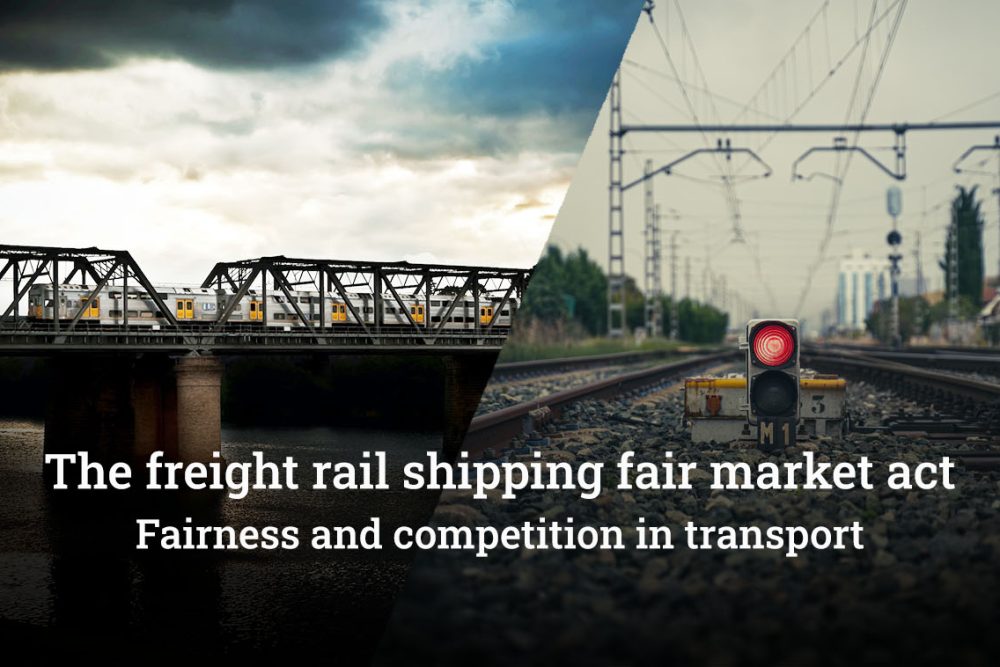Objectives of the act
The Freight Rail Shipping Fair Market Act has a clear mission: to make the freight rail industry fairer and more competitive. This comprehensive law focuses on three key areas: pricing, service quality, and competition. Let’s explore these goals in simpler terms to understand what the act aims to achieve.
Pricing rules
One essential part of the act deals with how prices are set. The law introduces rules that prevent railroads from raising prices too much, especially for important services. It also sets up a way to resolve pricing disputes fairly. This ensures that prices are clear and reasonable.
Service quality
Another crucial aspect of the Freight Rail Shipping Fair Market Act is improving the quality of service. The law sets strict standards for things like being on time and being reliable. This ensures that people who use rail transportation can trust it to be safe and dependable.
Fair competition
To encourage fair competition, the act tackles practices that could limit competition, like exclusive agreements and unfair access restrictions to rail infrastructure. This makes sure that everyone has a fair chance in the industry, from new players to established ones.
Impact on railroads
The act naturally affects the railroad industry itself. Companies will need to assess their service quality, focusing on aspects like punctuality and reliability. The act sets stringent standards in these areas, demanding that railroads provide dependable and on-time services. Consequently, railroads will need to streamline their operations, improve scheduling, and implement measures to ensure consistent service quality and at the same time stay profitable.
Benefits for shippers
Shippers, which are the companies that use railroads to move their goods, will benefit significantly from this law. They can expect lower shipping costs because of the rules on pricing. The law also makes pricing more transparent, so shippers can make informed decisions. And with better service reliability, shippers can rely on rail transportation to move their goods efficiently, making them more competitive.
Historical regulatory framework
To understand the significance of the Freight Rail Shipping Fair Market Act, it’s crucial to look back at the pivotal year of 1980 when significant changes reshaped the rail industry. Before these changes, government regulations tightly controlled rail operations, including pricing and services. However, these regulations had drawbacks, including stifling innovation and efficiency.
The 1980 reforms aimed to address these issues by granting railroads more pricing autonomy and the flexibility to provide customer-centric services. This newfound flexibility allowed railroads to compete, leading to improved pricing and service quality.
Much like the goals of the Freight Rail Shipping Fair Market Act, the 1980 reforms emphasized competition, enabling railroads to respond to market conditions with competitive pricing. This shift had a profound impact on the industry, revitalizing it by encouraging innovation and investment in infrastructure.
These changes also benefited railroads, as they could invest in infrastructure and enhance services, ultimately revitalizing an industry that had faced challenges before. Customers, known as “shippers,” gained more options, allowing them to negotiate better rates and services for their shipments. This made rail transport a more attractive and cost-effective choice.
International comparisons: A deeper dive into global rail regulation
In our quest to unravel the nuances of the Freight Rail Shipping Fair Market Act, we embark on a journey beyond borders, delving into international perspectives and regulatory approaches. By examining how various countries tackle similar challenges within the freight rail sector, we gain a more profound understanding of where this act stands in the global landscape. Insights of different authoritative sources provide a comprehensive view that enriches our comprehension of this transformative legislation.
European union: A unified approach
Within the European Union (EU), rail regulation takes on a distinctive character characterized by harmonization and unification. The EU’s Fourth Railway Package, consisting of a set of legislative measures, aims to create a single European railway area. This approach fosters interoperability, competition, and efficiency across member states. The emphasis on open access and competitive markets aligns with the objectives of the Freight Rail Shipping Fair Market Act.
Canada: Balancing commercial interests
In Canada, the freight rail sector is governed by the Canada Transportation Act. The regulatory framework seeks to strike a balance between commercial interests and the public good. The Canadian Transportation Agency plays a vital role in ensuring fair and reasonable rates for shippers. Notably, the act places importance on competitive access and service quality, echoing the objectives of the U.S. legislation.
Australia: A mix of competition and regulation
Australia’s rail industry operates under a mixed model of competition and regulation. The Australian Competition and Consumer Commission (ACCC) monitors rail access and pricing, ensuring that railroads do not engage in anti-competitive behavior. The combination of competition and regulatory oversight has resulted in a robust and competitive rail market, providing valuable insights for evaluating the U.S. approach.
Sweden: A Nordic perspective
In Sweden, the Transportstyrelsen oversees various modes of transportation, including railways. Sweden places a strong emphasis on efficiency, safety, and environmental sustainability within its transportation systems. Transportstyrelsen’s insights provide a Nordic perspective that underscores the significance of collaboration among regulatory bodies, rail operators, and shipping entities. This cooperative approach aligns with the core principles of the Freight Rail Shipping Fair Market Act, which seeks to promote collaborative efforts while ensuring fair competition.
As we look at how rail rules work worldwide, we see some common ideas. Countries want their freight rail systems to be efficient, competitive, and fair. This fits with what the Freight Rail Shipping Fair Market Act wants to do. Each country does things a bit differently, but they all want to create a fair game that helps both the industry and shippers.
In conclusion, the Freight Rail Shipping Fair Market Act aligns with how other countries regulate their rail industries. By looking at what other nations do, we can better understand where this act fits globally. This shows us that fairness, competition, and efficiency in rail transportation matter everywhere.
Sources:
- Association of American Railroads
- American Journal of Transportation
- Transportstyrelsen
- European Union: Fourth Railway Package
- Canada Transportation Act
- Australian Competition and Consumer Commission (ACCC)









